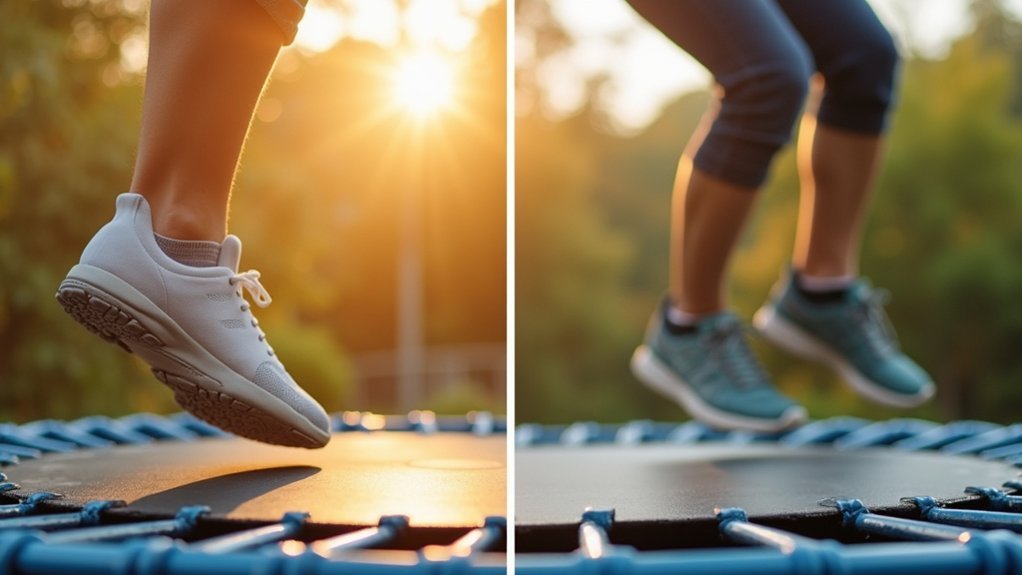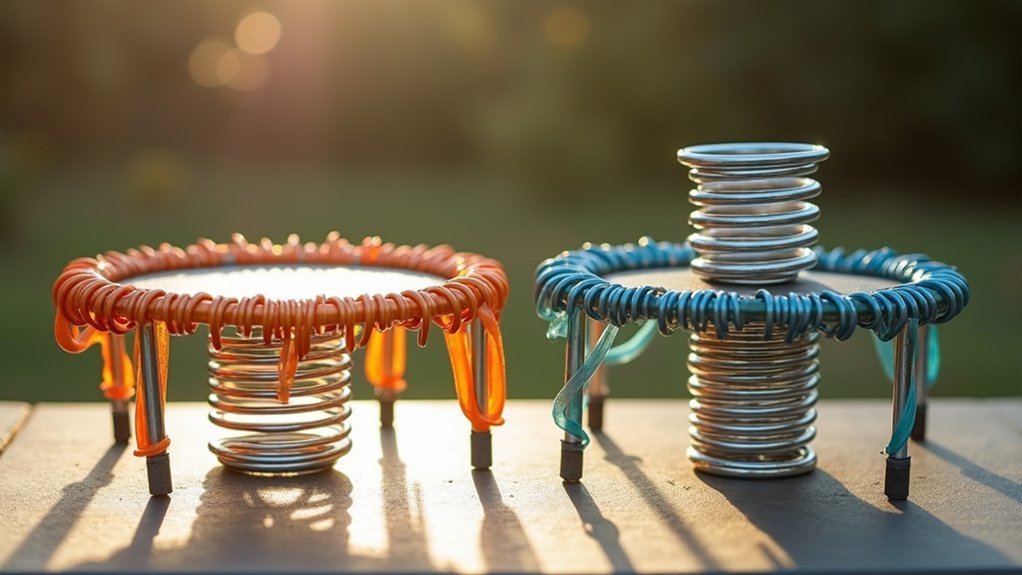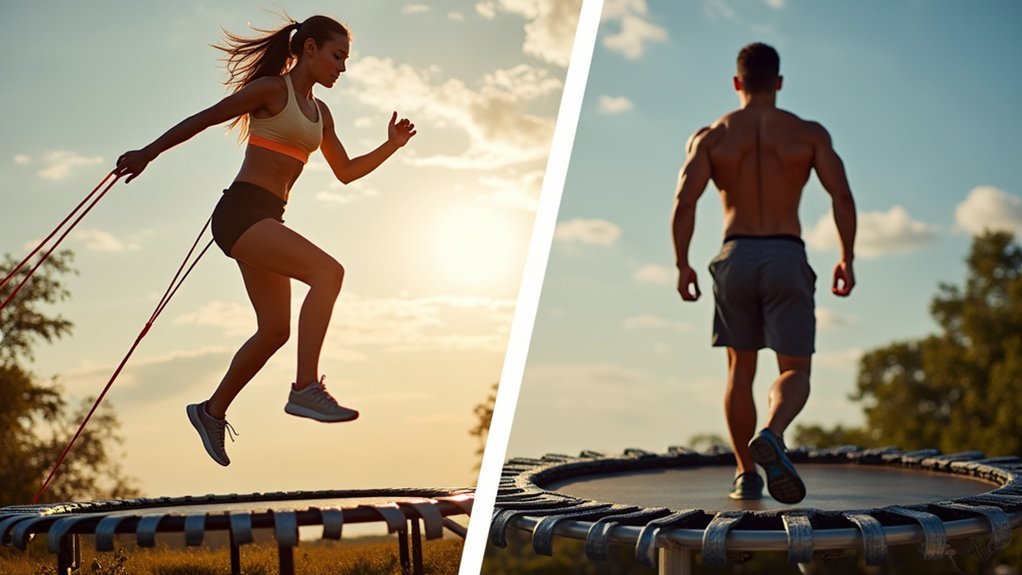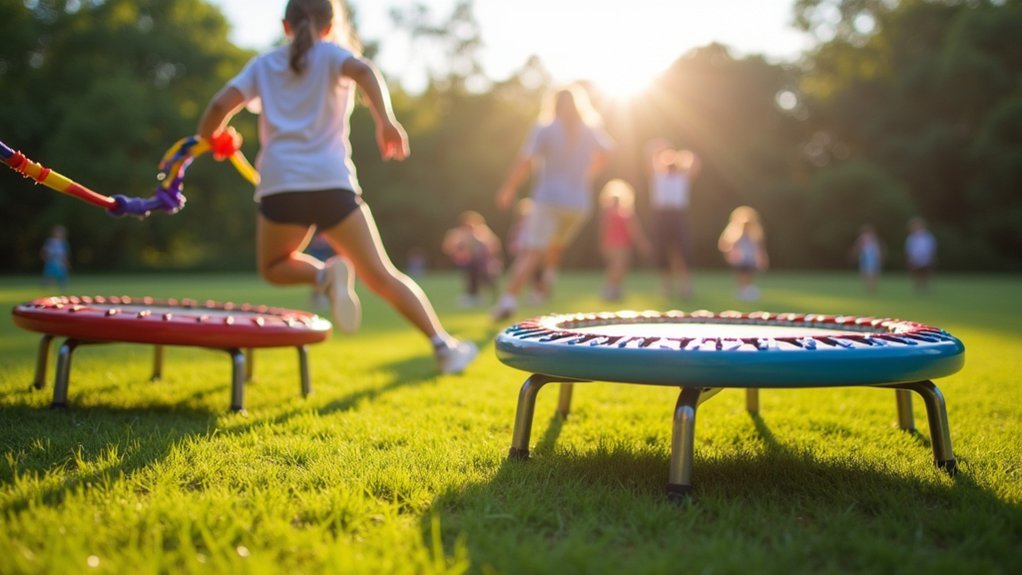Bungee rebounders offer a softer, quieter bounce that’s gentler on joints, making them ideal for therapeutic use and apartments. They provide customizable resistance but require cord replacement every 2-5 years. Spring rebounders deliver firmer, more responsive bounces preferred for intense workouts, with better durability and cheaper individual replacements. Your best choice depends on your fitness goals, joint health, and living situation. The right rebounder can transform your exercise routine beyond what you might expect.
Understanding Rebounder Fundamentals

Two main types of rebounders dominate the fitness market: spring and bungee models.
These compact trampolines differ greatly in how they support your bounce and what benefits they offer.
Spring rebounders use metal coils to create a firm, responsive bounce that’s ideal for high-intensity workouts and muscle toning.
Spring rebounders deliver a powerful workout experience through their metal coil design, perfect for those seeking intense muscle engagement.
They’re typically more stable and often come with adjustable features like resistance bands to vary your workout intensity.
In contrast, bungee rebounders utilize elastic cords for a softer, more controlled bounce.
They’re quieter, require less maintenance, and are particularly suitable for therapeutic purposes, lymphatic drainage, and users with mobility restrictions or joint concerns.
Your choice between these two types will depend on your fitness goals, physical condition, and whether you’re seeking an energetic workout or gentle, therapeutic movement.
While both types provide effective workouts, bungee models often receive higher ratings for their consistent surface tension that prevents discomfort during extended exercise sessions.
The Science Behind Bungee Cord Technology
Beneath every bounce on a bungee rebounder lies fascinating physics that makes these fitness tools uniquely effective. When you jump, the elastic cords stretch, storing potential energy that converts to kinetic energy as they return to their original state, propelling you upward.
Unlike metal springs, bungee cords provide variable tension that can be adjusted to your weight and exercise goals. This customizable resistance creates a smoother, more controlled bounce that absorbs impact effectively. Quality bungee rebounders feature strong bungees designed to support users weighing over 300 pounds without compromising performance.
You’ll notice the difference in how your joints feel after a workout. The elastic properties also eliminate metal-on-metal noise, giving you a quieter exercise experience.
This energy-efficient system supports fluid movements that enhance your balance and coordination while allowing for low-impact, joint-friendly aerobic workouts.
Spring Mechanics: How Traditional Rebounders Work

Traditional rebounders rely on a system of metal springs that create a distinctly different bouncing experience compared to bungee models.
These springs compress and extend with each jump, harnessing tension to generate a responsive, controlled bounce.
You’ll find that spring rebounders typically offer higher weight capacity and better stability for intense workouts.
The stiffness of the springs directly affects your rebound experience—firmer springs provide faster action while softer ones absorb more shock and reduce g-force impact on your joints.
Unlike springless designs that use flexible rods, spring rebounders deliver that classic “trampoline feel” many users prefer.
However, they do require occasional maintenance, as springs can wear out over time.
Your jumping weight and exercise style should guide your choice of spring tension for ideal performance and safety.
A NASA study demonstrated that the G-force measured at the ankle during trampoline exercise was more than twice that at the back and forehead while running, highlighting the effective stimulation of the body’s gravireceptors.
Impact Analysis: Joint Safety Comparison
When evaluating rebounders for joint health, the fundamental difference between spring and bungee models becomes immediately apparent in their impact profiles.
Spring systems provide a firm, responsive bounce that creates sharper ground reaction forces, requiring greater muscular stabilization but potentially increasing cumulative joint stress over time.
Spring rebounders offer responsive performance but may trade joint protection for intensity during extended use.
In contrast, bungee rebounders deliver a slower, more cushioned rebound cycle. Their elastic cords considerably reduce peak impact forces on your knees and hips, while dampening vibrations transferred to your spine. Bungee models are specifically recommended for conditions like osteo-arthritis and lymphoedema.
This gentler bounce allows for longer sessions without joint fatigue.
If you have joint sensitivity, arthritis, or are recovering from an injury, you’ll likely benefit from a bungee’s low-impact design.
Athletes and heavier users might prefer springs for their firmness and structural support.
Workout Efficiency: Calorie Burn Rates

Despite their structural differences, both types of rebounders ultimately challenge your body to expend energy—though they do so through distinctly different mechanisms.
Bungee rebounders increase calorie burn through prolonged muscle engagement and stabilization demands per bounce. The larger mat size of bungee rebounders provides more surface area for varied movement patterns, further enhancing workout efficiency. You’ll work harder with each movement due to the slower, more controlled nature of the bounce.
Spring rebounders leverage speed for intensity, enabling higher-tempo workouts that elevate your heart rate more quickly. This translates to average heart rates of 159 bpm during high-intensity sessions versus 127 bpm in moderate efforts.
Your weight considerably affects outcomes—a 208lb person burns 138-146 calories while a 128lb individual expends 65-87 calories in identical sessions.
Regardless of which model you choose, consistency with 20-30 minute daily sessions delivers the best results.
Durability and Maintenance Requirements
When choosing between bungee and spring rebounders, you’ll find significant differences in their longevity and upkeep requirements.
Bungee cords typically need replacement every 2-5 years while properly maintained springs may last longer, though both require regular inspection for safety and peak performance.
Your maintenance routine will include regular cleaning of the mat surface, checking for loose components, and replacing worn parts according to the manufacturer’s guidelines. For optimal performance of bungee rebounders, experts recommend checking cords every 3-6 months to identify signs of wear before they become safety hazards.
Longevity Comparison
Although both types of rebounders serve similar purposes, their longevity profiles differ greatly. When you invest in a rebounder, you’ll want to evaluate how it performs over time.
Spring rebounders maintain consistent reactivity throughout their lifespan, while bungee cords stretch and lose elasticity with regular use.
1. Performance Consistency – Springs offer reliable “spring back” during extended sessions, making them ideal for intense, high-frequency workouts.
Bungee rebounders require increasing effort as cords stretch over time.
2. Maintenance Requirements – Bungee cords need regular inspection and eventual replacement, though they’re easier to maintain with fewer metal components to rust. Spring rebounders often become quite noisy and may require periodic oiling to maintain proper function.
3. Long-term Value – Despite higher initial costs, spring rebounders typically provide better value through consistent performance, whereas bungee systems may incur ongoing replacement costs.
Replacement Part Needs
Regular maintenance and replacement of worn components directly impact the long-term value discussed earlier.
You’ll need to replace bungee cords every 2-5 years, while properly maintained springs might last longer, though individual spring replacement is common.
Bungee systems require tension checks and cord integrity assessments, while springs need monthly lubrication to minimize noise.
Both types demand mat inspections for fraying or holes. For optimal performance, clean all components with Clean Freek spray as it’s specially designed for rebounders.
When replacing parts, bungees typically involve entire cord set swaps ($20-$100+) and require precise tensioning.
Springs allow individual unit replacements ($10-$50 for 10-30 units) and need alignment checks afterward.
Be aware that bungee failures can cause sudden mat collapse, while broken springs create pressure points that accelerate mat wear.
Following manufacturer guidelines preserves warranty validity for both types.
Cleaning And Care
Proper cleaning and care routines greatly impact your rebounder’s performance and lifespan. Bungee systems need surface cleaning after each use to prevent sweat absorption, while spring models require detailed attention around coils where debris accumulates.
For effective maintenance:
- Choose appropriate cleaners – Use non-caustic wipes or mild soap for both types. Bungee models benefit from specialized cleaners like Clean Freek, while avoiding harsh chemicals that degrade cords.
- Implement climate-specific care – In humid environments, thoroughly dry spring mechanisms to prevent rusting. Apply silicone treatments to bungees in dry climates.
- Perform safety checks during cleaning – Verify bungee tension integrity, check spring alignment, and inspect mat attachment points for wear or damage. Maintaining a systematic checklist for these inspections will help prevent major repairs and extended periods of equipment downtime.
Never use garden hose washing on spring rebounders unless you can guarantee complete drying afterward.
Noise Levels for Home and Apartment Use
When choosing between spring and bungee rebounders for residential settings, noise level becomes a critical factor, especially in apartments or shared living spaces.
Spring models generate distinctive metallic squeaking from metal-on-metal friction, which intensifies with vigorous jumping and worsens as components wear.
Bungee rebounders offer markedly quieter operation—producing only soft, low-frequency thuds that rarely exceed conversational volume. They eliminate metal contact points entirely, reducing noise by 50-70% compared to spring models. All bungee models are designed to be completely quiet during use, making them ideal for home workouts at any time of day.
Beyond audible sound, vibration transmission matters too. Springs create resonant vibrations that travel through floors and walls, potentially disturbing neighbors.
Bungee systems absorb impact energy, minimizing structural vibration transfer.
For apartments or noise-sensitive environments, bungee rebounders clearly outperform spring models without requiring the regular lubrication maintenance that springs demand.
Budget Considerations: Upfront and Long-term Costs
Comparing the financial impact of spring and bungee rebounders reveals notable differences in both initial investment and long-term ownership costs.
While bungee models typically command higher upfront prices, particularly for premium versions with advanced tension systems and warranties, spring rebounders offer more accessible entry points for beginners.
- Initial Investment – Budget spring rebounders start at lower price points than comparable bungee models, though luxury bungee options include additional features like online workout access.
- Replacement Economics – Springs last 3-5+ years and can be replaced individually ($2-$5 each), while bungee cords require replacement every 1-3 years, often as complete sets.
- Usage Intensity Impact – Heavy users (5+ hours/week) face notably higher maintenance costs with bungee systems, making springs more economical for frequent rebounding despite higher shipping costs for parts. Quality bungee rebounders, however, offer 60 bungee connectors for a consistently comfortable bounce experience that may justify the additional expense.
Exercise Versatility and Workout Adaptation
Your rebounder choice directly impacts the types of workouts you’ll perform, with springs excelling in high-impact, rapid movements while bungees shine for rehabilitation and low-impact exercises.
You can expand your fitness routine by selecting a model that complements your cross-training goals, whether that’s integrating weight training with a spring system or enhancing flexibility work with a bungee’s gentler bounce. Spring-loaded models are particularly suitable for HIIT and Tabata exercises due to their firmer, quicker recoil characteristics.
As you progress in your fitness journey, a bungee rebounder’s adjustable tension offers room to grow, while spring systems provide the consistent resistance needed for advanced plyometric training.
High-Impact Versus Low-Impact
The fundamental difference between spring and bungee rebounders lies in their impact profiles and exercise versatility.
Spring rebounders deliver firm, quick bounces that excel in high-intensity cardio workouts, while bungee systems offer gentler landings that protect your joints during extended sessions. Bungee rebounders provide a smoother bounce quality compared to spring rebounders, which contributes to their joint-friendly nature.
Your workout goals should guide your choice:
- Intensity Level – Choose springs for rapid, high-impact training that builds agility and speed; select bungee for low-impact strengthening with reduced joint stress.
- Recovery Needs – Bungee systems provide better support for rehabilitation exercises and recovery sessions after intense workouts.
- Adaptability – Springs accommodate fast-paced exercises requiring quick rebounds, while bungee rebounders allow customizable resistance for various fitness levels.
The right rebounder depends on whether you prioritize high-intensity performance or joint-friendly, sustainable exercise routines.
Cross-Training Compatibility
While both rebounder types offer fitness versatility, they shine in different cross-training scenarios.
Spring rebounders excel at complementing high-intensity workouts like HIIT and plyometrics, providing energetic bounces that facilitate rapid tempo changes. You’ll find they integrate seamlessly with cardio routines and dynamic exercises that enhance aerobic capacity.
In contrast, bungee rebounders offer greater workout customization with their adjustable tension settings and larger mat surface. You can easily incorporate multi-directional movements, strength training with resistance bands, and yoga sequences.
Their gentle, smooth motion makes them ideal for injury rehabilitation and active recovery sessions.
Both options can be tailored to your individual training style, whether you’re focusing on core strengthening or combining them with other fitness tools like resistance bands or interactive apps.
Progressive Fitness Levels
Considering your fitness journey’s evolution, both rebounder types offer distinctly different paths for progressing through various intensity levels.
Spring rebounders provide a firmer bounce that naturally supports advancement in fitness, allowing you to challenge yourself with higher jumps and quicker movements as you grow stronger.
- Spring rebounders excel at supporting progressive fitness through their responsive bounce, enabling you to add resistance training elements or increase intensity as your capabilities improve.
- Bungee rebounders offer a gentler entry point with their softer landing, making them ideal if you’re shifting from lower activity levels or recovering from injury.
- Workout adaptability varies between models – springs facilitate dynamic, high-intensity progression while bungees accommodate gradual advancement with reduced joint stress.
Fitness Expert Recommendations
Fitness experts consistently favor bungee rebounders over spring models for several key reasons.
Their professional assessment highlights bungee systems’ superior joint protection through smoother, controlled bounces that absorb impact more effectively.
You’ll find trainers recommending bungee models for their workout efficiency—they require more effort per bounce, potentially increasing your calorie burn.
The noise difference is also significant; bungee rebounders operate quietly without the squeaking that plagues spring models over time.
Safety considerations drive many expert recommendations, particularly for households with children or elderly users, as bungee systems eliminate pinch hazards from exposed springs.
This explains why fitness professionals observe a one-way migration pattern: users frequently upgrade from spring to bungee rebounders for comfort and adjustability, but rarely switch back.
Families with children or individuals with special educational needs often benefit most from bungee rebounders’ controlled, quieter bounce characteristics.
Customer Satisfaction: What Users Report
The real-world experiences of rebounder owners often tell a different story than marketing materials suggest. When surveying customer feedback, clear patterns emerge in what satisfies and frustrates users.
1. Durability concerns – Spring rebounders typically outlast bungee models, with many users reporting cord breakage within months of purchasing bungee units.
You’ll likely face less maintenance with springs. High-quality springs deliver consistent performance throughout years of regular use.
2. Noise considerations – If you’re exercising in shared spaces or early mornings, bungee rebounders offer a notably quieter experience that won’t disturb others.
3. Bounce preference – Your workout goals matter here.
Bungee rebounders provide a gentler, low-impact experience ideal for joint sensitivity, while spring models deliver a firmer, more responsive bounce that many find better for intense workouts.
Selecting the Right Rebounder for Your Fitness Goals
Choosing the right rebounder requires aligning the equipment with your specific fitness objectives.
If you’re seeking higher-intensity workouts with explosive movements, a spring rebounder’s firm bounce and quick recoil will better support your HIIT-style training.
For rehabilitation purposes or if you have joint concerns, you’ll benefit from a bungee model’s superior impact absorption and gentler bounce pattern.
Consider that bungee rebounders offer a wider surface area for more comfortable landings while requiring greater effort for the same workout duration compared to spring models.
Goal-Specific Rebounder Selection
Selecting the right rebounder depends largely on your fitness objectives and physical condition. Spring rebounders offer faster response for athletic training, while bungee models provide gentler impact for rehabilitation needs.
- Athletic Performance – Choose spring rebounders for high-intensity workouts, explosive movements, and agility training. They enable quicker direction changes and typically burn more calories in shorter sessions.
- Rehabilitation & Low-Impact Exercise – Opt for bungee rebounders if you have joint issues, are post-surgery, or elderly. Their slower return minimizes spinal compression and reduces overall joint stress.
- Practical Considerations – Spring models are generally more affordable and portable, but produce noise and require maintenance.
Bungee systems offer quieter operation and eliminate pinch hazards, though they’re typically more expensive to replace.
Impact vs. Intensity
Understanding the relationship between impact and intensity helps you find the perfect rebounder match for your body’s needs and fitness aspirations. Bungee rebounders offer superior joint protection with their softer absorption, making them ideal for injury recovery and sensitive joints. In contrast, spring rebounders deliver faster bounce response, better suited for high-intensity interval training.
| Feature | Bungee Rebounders | Spring Rebounders |
|---|---|---|
| Joint Impact | Very Low | Low-Medium |
| Workout Intensity | Requires more effort | Quicker response |
| Ideal For | Rehabilitation, joint issues | HIIT, cardio efficiency |
| Calorie Burn | Higher per movement | Faster rhythm possible |
If you’re recovering from injury or prioritize joint health, choose bungee. For maximum cardio efficiency and quick-tempo workouts, springs might serve you better. Your specific fitness goals should guide this important decision.
Frequently Asked Questions
Can Rebounders Help With Specific Medical Conditions Like Fibromyalgia?
Yes, rebounding can help with fibromyalgia by improving lymphatic flow, reducing pain, and enhancing circulation. You’ll benefit from its low-impact nature that won’t strain your sensitive joints while still providing exercise benefits.
Are There Weight Limits That Differ Between Bungee and Spring Models?
Yes, weight limits do differ. You’ll find bungee models generally support higher weights (up to 440lbs in premium designs) while spring rebounders typically max out at 120kg/265lbs, with some specialized models reaching 400-500lbs.
How Do Rebounders Affect Balance and Coordination in Older Adults?
Rebounders greatly improve your balance and coordination as you age. You’ll experience enhanced proprioception, reduced fall risk, and better daily mobility through the constant adjustments your body makes during bouncing sessions.
Can Children Safely Use Both Types of Rebounders?
Children over 6 can use rebounders, but bungee models offer better safety with softer landings and no spring entrapment risks. You’ll need to supervise closely regardless of which type you choose.
Do Rebounding Workouts Complement Other Fitness Activities Like Weight Training?
Yes, rebounding workouts perfectly complement weight training. You’ll improve cardiovascular health while strengthening core muscles. They’re low-impact, allowing recovery between weight sessions while still maintaining fitness and boosting overall endurance.
In Summary
Your choice between bungee and spring rebounders depends on your specific needs. If you’re prioritizing joint protection and workout variety, bungee models offer superior shock absorption and versatility. For budget-conscious exercisers who prefer traditional bouncing, spring rebounders work well. Consider your fitness goals, health requirements, and lifestyle before investing. Remember, the best rebounder isn’t necessarily the most expensive—it’s the one you’ll use consistently.





Leave a Reply